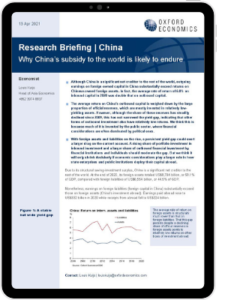China | Why China’s subsidy to the world is likely to endure

China is a significant net creditor to the rest of the world. At the end of 2020, its foreign assets totaled US$8,704 billion, or 59.1% of GDP, compared with foreign liabilities of US$6,554 billion, or 44.5% of GDP.
Nonetheless, earnings on foreign liabilities (foreign capital in China) substantially exceed those on foreign assets (China’s investment abroad). In fact, the average rate of return of 6.0% on inbound capital in 2020 was double that on outbound capital.
Download the report to find out:
- Why is the gap in return so large?
- Will the yield gap narrow?
- Will China’s foreign assets and liabilities continue to rise?
Tags:
Related Services

Post
UK: Supply constraints are probably less prominent in the south
The extent to which UK employers can respond to likely 2024 interest rate cuts with increased output, rather than rises in prices and wages, will partly reflect the extent of spare capacity. This will inevitably vary by region. Evidence on this is imperfect, but in terms of capital assets (including intangibles) and labour availability, southern regions appear to be in a stronger position than those in the UK's traditional industrial heartland.
Find Out More
Post
Global Private equity real estate fund maturities spur asset sales
We expect the significant increases in fund maturities, spurred by capital raised over the past decade, to exert upward pressure on the rate of asset disposals as the funds approach the end of their lifecycles.
Find Out More